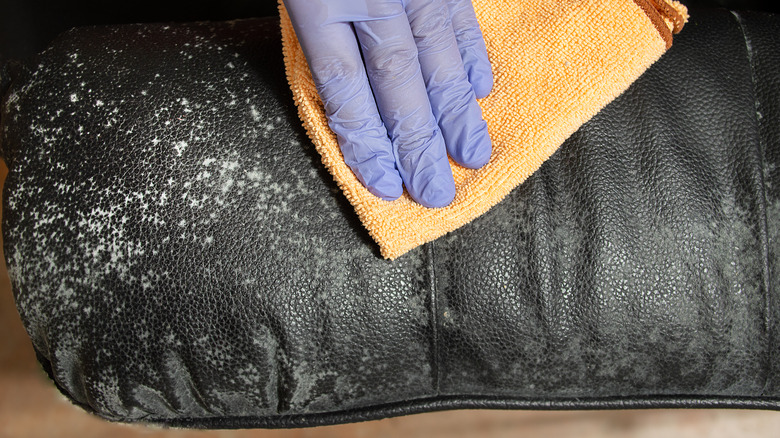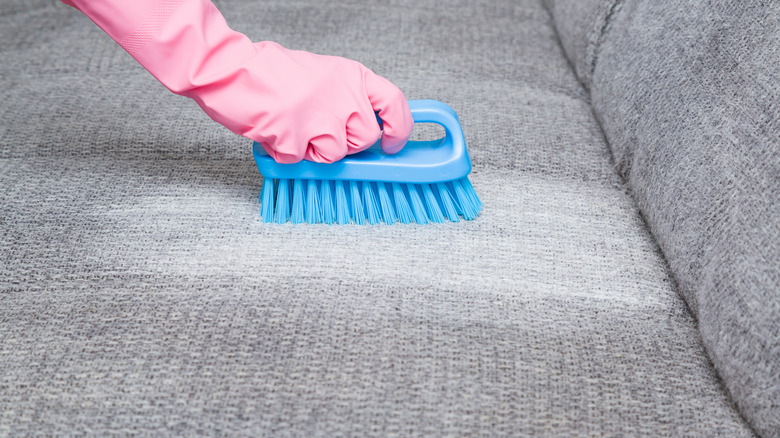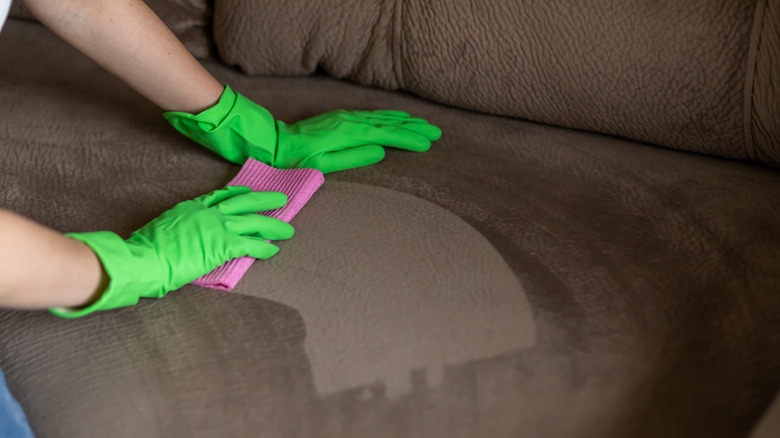Remove Mold From Your Sofa With These Handy Home Essentials
If your home has a moisture and humidity problem, it might be ripe for mold accumulation. Once those spores enter your home, they can attach to almost anything, including upholstered items like your sofa. The good news is you probably already have what you need in the kitchen to rid your couch of mold: vinegar or hydrogen peroxide. Couches can be the perfect place for mold to proliferate because of fabric's porous nature which allows it to soak up the moisture. You can tell if spores are starting to grow on your sofa if it starts to smell funky. You may also be able to see it growing visibly. Mold can appear as white, black, green, or grey splotches and marks.
Mold exposure can lead to a whole slew of health problems, including memory loss, asthma, lethargy, and, in the most severe cases, death. So, it probably goes without saying that you'll want to get rid of it as soon as possible. Once you remediate the source of your moisture and humidity to prevent the mold from continuing to grow, you'll want to start cleaning up the mold that's already in your home. Here are some of the easiest ways to clean mold off your couch using handy home essentials.
How to use vinegar to get mold off of your couch
To remove mold from your couch using vinegar, you'll also need a stiff-bristled brush, a sponge, a vacuum, fungicide spray, newspaper, and a container. You may also want to consider wearing a mask so you don't breathe in the mold. Place your newspaper on the floor around your sofa and rub your couch down with the dry brush. This will drive up the spores, leaving the newspaper to catch them.
Go over your couch with your vacuum cleaner to suck up any remaining debris. If you have a bagless vacuum, you'll want to spray the inside with anti-mold spray first so mold doesn't start growing in your vacuum. If you have a bag, be sure to toss the bag out afterward. Pour a mixture of equal parts vinegar and warm water into your container, then dunk your sponge in and let it soak up the mixture well. Use the sponge to wet and wipe away any mold spots.
Wring out and rinse your sponge as you clean your sofa. When you're done, place your couch in an area with good ventilation. Putting your couch in sunlight will also help with killing and preventing mold. Open some windows or place a fan in front of your couch to aid with drying. Next, use an upholstery-friendly fungicide spray to spray your couch. Let it dry completely before sitting on your sofa again.
How to use hydrogen peroxide and why these ingredients work
Another surprising way to use hydrogen peroxide in your home is to get rid of mold. For this method, prepare your couch using the same items and procedure as above. However, instead of using vinegar and water, you'll soak a sponge in 3% hydrogen peroxide. Use this to wipe your mold stain. Then, take a second sponge with warm water and use it to wash away the hydrogen peroxide. Use a dry cloth to dry the area. Repeat these steps until the mold stains are gone. You can then dry the couch by placing it in the sun or pointing a fan at the surface.
The reason why vinegar works against mold is because its acidity can fend off moisture deterioration, and it has antibacterial properties. Hydrogen peroxide is effective against mold because of its rapid oxygen-releasing abilities. This oxidizes the mold's surface and breaks down its proteins and DNA, which destroys the mold. Either of these ingredients should work wonders and make your couch look brand new again.


